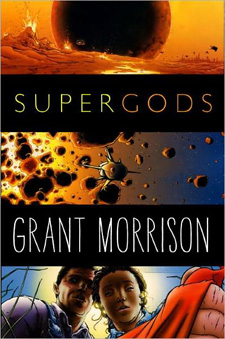Read This: My Freelance Harmonic Convergence
Yesterday was an interesting day: Three of the book-related posts I’d written for other websites were published within a few hours of each other, giving me a lot to talk about that afternoon. “Whatcha Reading, Jennifer Weiner?” is the latest in my regular series of short interviews for inReads.com—I’d conducted a more extensive interview with Jennifer about her latest novel, Then Came You, for a Beatrice project that’s still in development, but I used a few minutes at the end to get her talking about The Kid, Sapphire’s long-awaited second novel. She does such a good job of “selling” the book that one of my friends on Twitter said that watching the video made her want to buy it and read it. And that, as I’m sure I’ve said somewhere before, constitutes a successful day as far as I’m concerned.
Then there was my weekly post for USA’s Character Approved blog, focusing on Téa Obreht and her debut novel, The Tiger’s Wife. I’d been hearing great things about this book for several months, and the Orange Prize that Obreht won last month kept it on my radar, but I’d never quite found the time to read it until last week. I’m glad I did: It’s a fascinating hybrid of a novel; Obreht’s young first-person narrator describes the chaotic impact of civil war on her Eastern European homeland, but she also shares stories from her grandfather’s life that inject a welcome dose of fantasy. I found myself equally caught up in both halves of the novel, and I was delighted by how Obreht ultimately tied everything together. I’ll be looking forward to seeing what she does with her next book.
 Finally, over at Tor.com, I reviewed two books about superheroes as our newest archetypes, but really only one of those books was any good: Grant Morrison’s Supergods. Of course, I have to confess that I’ve been a fan of Grant Morrison’s comic books for just over two decades now, and series like Doom Patrol and The Invisibles have become significant touchstones in my creative philosophy. So I was predisposed in some ways to like this book, which starts out as a sort of cultural history of American comic books—the comparison I draw in the review is to Greil Marcus’ Lipstick Traces—which takes on an autobiographical perspective about halfway through, and eventually works its way to Morrison’s theories about extradimensional intelligences who might view our reality in the same way that we view the world(s) depicted in comic books.
Finally, over at Tor.com, I reviewed two books about superheroes as our newest archetypes, but really only one of those books was any good: Grant Morrison’s Supergods. Of course, I have to confess that I’ve been a fan of Grant Morrison’s comic books for just over two decades now, and series like Doom Patrol and The Invisibles have become significant touchstones in my creative philosophy. So I was predisposed in some ways to like this book, which starts out as a sort of cultural history of American comic books—the comparison I draw in the review is to Greil Marcus’ Lipstick Traces—which takes on an autobiographical perspective about halfway through, and eventually works its way to Morrison’s theories about extradimensional intelligences who might view our reality in the same way that we view the world(s) depicted in comic books.
But while Supergods is powerfully inspired, I did find myself wanting more in some places, especially the lost opportunity to go into detail about Morrison’s specific approach to the Batman character over the last half-decade. I’d also say that while the book is loaded with incisive descriptive analysis of comics from the first appearance of Superman right up to the present day, it feels a bit rushed at the end, as if the threads weren’t tied together quite as tightly as they could have been. Still, there’s a lot of amazing stuff crammed in there, more than I was able to fit into my review (especially since I had to spend some time on a book that got wrong nearly everything Supergods got right).
I’d have loved, for example, to delve into Morrison’s application of the chaos magic technique of “hypersigils” to his comic books, a topic I’ve previously tackled in an essay about Dan Brown’s The Lost Symbol—one of several aspects of Supergods that are driving mainstream critics at places like The New York Times and The Wall Street Journal nuts. (They’re also shocked and outraged that Morrison is unapologetic about those occult practices and the intersecting drug use.) But I see that the University Press of Mississippi has a book about Morrison coming out later this year; maybe that will give me another chance to expand on some of those ideas…
21 July 2011 | read this |
Rae Bryant Ponders Nabokov’s Signs & Symbols

Rae Bryant is coming to New York City later this week to launch her debut short story collection, The Indefinite State of Imaginary Morals, with a Saturday night reading at KGB Bar. In stories like “Postfeminist Zombie Assassins Wear Wonder Woman Underoos,” “Emperatriz de la Orilla del Río,” and “Featherbedding,” Bryant writes about desire with a dream-like quality: “If an average person thinks about sex several times a day,” she told The Nervous Breakdown, “then a single story without the convergence of gender and sex would be a dishonest slice of a natural day. I like natural days. I like to see them stretched and twisted and formed through surreal lenses.” It seems fitting, then, that she would be drawn to the stories, both short and long, of Nabokov…
Nabokov was a master at cutting his readers. His words are dexterous and sharp.
I came to Nabokov by way of Lolita, which may very well be my favorite novel, though tomorrow it will be McCarthy’s Blood Meridian. So today, Lolita.
One of the masteries in Nabokov’s stories, what I admire so much, is how smoothly the stories turn readers into accomplices. In Lolita, we begin cautiously, cringing at Humbert Humbert’s “Lolita… fire of my loins.” The lulling beauty of young Humbert’s language and his flashback affair with age-appropriate Annabel draws the reader into an acceptable narrative and set of mores. The subsequent transition to immorality is seamless. The crafting, perfection. The reader accepts Humbert as an emotionally stunted man, a child, and so accepts his replacement of the dead Annabel with a live and young Lo, who is something of his emotional equal. The moral cutting is almost imperceptible and before the reader fully realizes it, taboo has been severed from its leash and an addiction has formed for Humbert’s voice, his past, his self-delusions and the promise of a painful end. The reader sits quietly in the backseat of Humbert’s car and experiences the relationship unfold between him and his nymphet, one touch after another. Yes, reading Lolita is to be wounded. Nabokov takes his readers to dark places they swore they’d never go.
At times, it is easy to forget Humbert’s abuses as they’re narrated through his romanticized point of view. Further consider the socio-political layers, the undercurrent of commentary, the language play, double entendres and coded phrasings, and this all becomes really quite genius as much as it is vicious. The reader becomes a willing participant in this horror, an accomplice and confidante to Humbert’s actions, because one does not “watch” Lolita, one immerses.
Multi-faceted architecture recurs in all of Nabokov’s works, another being “Signs and Symbols,” re-titled “Symbols and Signs” by The New Yorker when they published the story in 1948. An unnamed son suffers from “referential mania” with an elaborate coding behavior by which he perceives everything around him as references to himself: “Everything is a cipher and of everything he is the theme.” The boy’s parents visit him on his birthday but are not able to see him in the sanitarium because the son has tried to kill himself again, and the nurses believe the parents would further agitate him. The day turns into a journey home, filled with images of a twitching bird, twitching hands, birds with human hands and feet, allusions to the son’s condition, artistic artifacts, Holocaustic history and perhaps the question, what is reality?
Like Lolita, “Signs and Symbols” delivers these artifacts by making the reader an accomplice, an archaeologist who excavates meanings along the way, realizing at the end, the question may not exist in the son’s condition but perhaps in the systems by which these conditions are catalogued. Nabokov doesn’t “tell” the reader to search socially, but rather, he uses the reader to formulate the hypothesis along the way—reality is not always the answer.
In June 2008, Mary Gaitskill gave a gorgeous online reading of “Symbols and Signs” at the New Yorker website. Interestingly, Gaitskill read from the Nabokov’s Dozen version of the story with his original title, rather than read the one in the magazine’s archives. In her post-reading discussion with Deborah Treisman, Gaitskill elaborated on the beauty and “tonalities” of the work while being somewhat resistant to discussing the coded language and layered narratives that are so often central to Nabokov’s stories. In Gaitskill’s discourse, is a sense of artistic agnosticism, a willingness to experience the story in its immediacy, linger in the constancy of searching without forcing a particular answer. Nabokov’s stories are good for this constancy of searching, as much as they are good for any other critical approach. For this reason, I return to Nabokov’s works often as a place of wonderment, morality and tireless questioning.
20 July 2011 | selling shorts |

 Our Endless and Proper Work is my new book with Belt Publishing about starting (and sticking to) a productive writing practice.
Our Endless and Proper Work is my new book with Belt Publishing about starting (and sticking to) a productive writing practice. 
